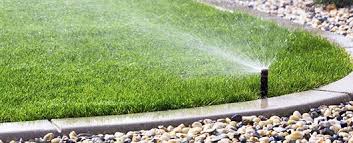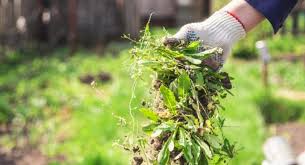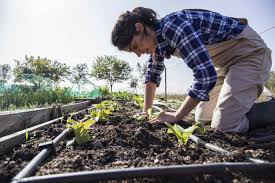Cultivation practices are the foundation of successful farming. These practices include soil preparation, planting, weeding, irrigation, and fertilization. By mastering these methods, farmers can ensure healthy crop growth, maximize yields, and maintain sustainable farming operations. Effective cultivation practices are essential for ensuring the long-term productivity of the land.
Weeding Techniques and Best Practices
Weeds compete with crops for nutrients, water, and sunlight, reducing yields and overall crop health. Managing weeds efficiently is a crucial part of cultivation.
1. Hand Weeding: This traditional method involves manually pulling out weeds from the soil. It’s labor-intensive but effective, particularly in small-scale farms or gardens where precision is important.
2. Mulching: Mulching involves covering the soil with organic materials like straw, leaves, or compost. This helps to suppress weed growth by blocking sunlight, maintaining soil moisture, and improving soil health.
3. Mechanical Weeding: For larger farms, mechanical weeders like hoes and cultivators can be used. These machines disturb the soil, uprooting weeds while leaving crops intact. This method is more efficient for covering large areas.
4. Herbicide Application: Herbicides can be used to control weeds on large farms. Selective herbicides target specific types of weeds without harming crops. However, careful application is required to avoid damaging crops or the environment.
5. Crop Rotation: Changing the crops grown in a particular field each season can naturally reduce the weed population. Certain crops, like legumes, can suppress weeds due to their growth patterns and nutrient needs.
Effective Irrigation Methods

Water is critical for plant growth, and proper irrigation ensures that crops receive the right amount of moisture. Here are some of the most effective irrigation methods:
1. Drip Irrigation: This method delivers water directly to the roots of plants through a network of tubes and emitters. It conserves water, reduces evaporation, and ensures that plants receive consistent moisture. Drip irrigation is ideal for areas with limited water resources.
2. Sprinkler Irrigation: Sprinkler systems distribute water evenly across the field, mimicking rainfall. These systems can cover large areas, making them ideal for larger farms. However, they can result in water loss due to evaporation, especially in hot climates.
3. Furrow Irrigation: This method involves creating small trenches or furrows between crop rows and allowing water to flow through them. Furrow irrigation is simple and inexpensive, but it may not be as water-efficient as other methods.
4. Subsurface Irrigation: This method delivers water below the soil surface, directly to the plant roots. It’s highly efficient and reduces water loss from evaporation. However, it requires significant installation costs.
5. Manual Irrigation: On small-scale farms or gardens, farmers may use hoses, buckets, or watering cans to irrigate crops. This method is labor-intensive but gives farmers complete control over how much water each plant receives.
Fertilization: Types and Application
Fertilizers provide essential nutrients that crops need to grow and thrive. There are different types of fertilizers and methods for applying them to ensure effective nutrient delivery.
1. Organic Fertilizers: Organic fertilizers are derived from natural materials such as compost, manure, and plant residues. They improve soil structure, increase microbial activity, and release nutrients slowly. Organic fertilizers are ideal for sustainable and environmentally friendly farming practices.
2. Inorganic (Synthetic) Fertilizers: These fertilizers are manufactured and provide nutrients like nitrogen, phosphorus, and potassium in concentrated forms. They offer quick nutrient availability to crops but may deplete soil health in the long term if overused.
3. Foliar Fertilization: In this method, liquid fertilizers are sprayed directly onto the leaves of the plants. Plants absorb nutrients through their leaves, providing a quick nutrient boost. Foliar fertilization is often used to correct nutrient deficiencies.
4. Broadcast Application: Fertilizers are spread evenly across the field, either by hand or with a mechanical spreader. This method is efficient for large areas but may result in uneven nutrient distribution.
5. Banding: Fertilizers are applied in concentrated strips or bands near the plant roots. This method ensures that nutrients are readily available to the plant, reducing the risk of nutrient runoff or wastage.
6. Fertigation: This technique combines irrigation with fertilization, delivering nutrients through the water system. It ensures precise nutrient application and is commonly used with drip irrigation systems.
Read Also: Worm Infestation on Ruminant Animals: Symptoms and Treatment
Pest Management Strategies

Effective pest management is crucial in cultivation to ensure healthy plant growth and prevent yield losses. Pest management strategies involve using various techniques to control or eliminate pests without harming crops or the environment.
1. Biological Control: This strategy involves introducing natural predators, such as ladybugs, parasitic wasps, or nematodes, to control pest populations. These beneficial organisms feed on or parasitize pests, reducing their numbers without chemicals.
2. Cultural Control: Cultural practices help prevent pest infestations by creating an environment less favorable for pests. This can include crop rotation, planting pest-resistant varieties, and managing plant spacing to improve airflow and reduce humidity, which discourages pest development.
3. Mechanical Control: This method includes physical removal of pests using traps, barriers, or manual picking. For example, sticky traps can catch flying insects, and row covers can protect crops from insect damage.
4. Chemical Control: In cases where pest infestations are severe, chemical pesticides may be necessary. However, it’s important to use them sparingly and follow recommended guidelines to avoid harming beneficial organisms or polluting the environment.
5. Integrated Pest Management (IPM): IPM combines multiple pest management strategies to minimize pest damage. This method emphasizes monitoring pest populations, using biological and cultural controls, and only applying chemical pesticides when absolutely necessary. IPM is a sustainable approach to pest control that reduces reliance on chemicals.
Disease Control in Cultivation
Plant diseases can devastate crops, so disease control is vital for healthy cultivation. Preventative measures and proper disease management can protect plants from common diseases.
1. Crop Rotation: Rotating crops helps break the life cycle of soil-borne pathogens. By changing the type of crop grown in a field each season, you reduce the chances of disease buildup in the soil.
2. Use of Resistant Varieties: Growing disease-resistant crop varieties is an effective way to prevent infections. These plants are bred to resist specific pathogens, reducing the need for chemical treatments.
3. Proper Spacing and Air Circulation: Overcrowded plants can create humid conditions that promote disease development. Proper plant spacing ensures good air circulation, reducing moisture levels and the likelihood of disease outbreaks.
4. Sanitation: Keeping the growing area clean is essential to prevent the spread of disease. Removing infected plants, cleaning tools, and maintaining healthy soil can help control disease spread.
5. Fungicides: In cases where fungal infections are present, fungicides may be used to treat the affected plants. However, like pesticides, they should be applied responsibly and only when necessary.
6. Crop Quarantine: Isolating diseased plants from healthy ones helps prevent the spread of disease. This strategy is particularly important when introducing new plants to an existing crop.
Read Also: Goat Milk Production Complete Guide
Integrating Weeding, Irrigation, Fertilization, and Pest Control

Successful cultivation requires integrating various farming practices to create a balanced system where plants thrive. Here’s how you can combine weeding, irrigation, fertilization, and pest control effectively:
1. Timing is Key: Ensure that weeding, irrigation, and fertilization are done at the right time to complement each other. For example, weed before applying fertilizers or irrigation to prevent weeds from benefiting from added nutrients or water.
2. Mulching for Multiple Benefits: Mulching not only controls weeds but also conserves moisture and improves soil fertility over time. By integrating mulching into your pest management strategy, you reduce weed growth and create healthier soil conditions for crops.
3. Drip Irrigation for Efficiency: Using drip irrigation helps reduce water waste and prevents overwatering, which can encourage disease. Combining drip irrigation with fertigation (fertilizing through irrigation) ensures that plants receive nutrients and water directly at the roots.
4. Monitor for Pests Regularly: Regular monitoring allows you to spot pest problems early. Integrated Pest Management (IPM) works well when combined with irrigation and fertilization schedules since healthy plants are more resistant to pests.
5. Organic Fertilizers for Soil Health: Organic fertilizers not only nourish crops but also promote beneficial microbial activity in the soil, which helps control diseases naturally. Healthy soil is less prone to harbor pests and pathogens.
6. Companion Planting: Planting certain crops together can naturally deter pests. For example, planting marigolds alongside tomatoes can repel nematodes and other harmful pests, integrating pest control into your cropping plan.
By integrating weeding, irrigation, fertilization, and pest control, you create a harmonious and efficient farming system. These practices, when used together, improve plant health, reduce pest and disease issues, and increase overall productivity, leading to a more sustainable and successful cultivation process.
Do you have any questions, suggestions, or contributions? If so, please feel free to use the comment box below to share your thoughts. We also encourage you to kindly share this information with others who might benefit from it. Since we can’t reach everyone at once, we truly appreciate your help in spreading the word. Thank you so much for your support and for sharing!

